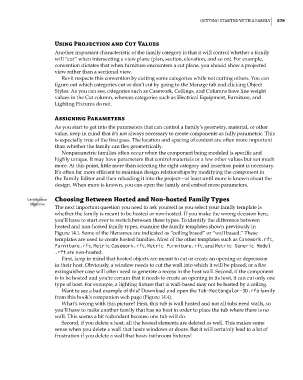Page 613 - Divyank Tyagi
P. 613
|
getting starteD with a Family 579
Using projection and Cut Values
Another important characteristic of the family category is that it will control whether a family
will “cut” when intersecting a view plane (plan, section, elevation, and so on). For example,
convention dictates that when furniture encounters a cut plane, you should show a projected
view rather than a sectional view.
Revit respects this convention by cutting some categories while not cutting others. You can
figure out which categories cut or don’t cut by going to the Manage tab and clicking Object
Styles. As you can see, categories such as Casework, Ceilings, and Columns have line weight
values in the Cut column, whereas categories such as Electrical Equipment, Furniture, and
Lighting Fixtures do not.
assigning parameters
As you start to get into the parameters that can control a family’s geometry, material, or other
value, keep in mind that it’s not always necessary to create components as fully parametric. This
is especially true of the first pass. The location and spacing of content are often more important
than whether the family can flex geometrically.
Nonparametric families often occur when the component being modeled is specific and
highly unique. It may have parameters that control materials or a few other values but not much
more. At this point, little more than selecting the right category and insertion point is necessary.
It’s often far more efficient to maintain design relationships by modifying the component in
the Family Editor and then reloading it into the project—at least until more is known about the
design. When more is known, you can open the family and embed more parameters.
Certification Choosing Between hosted and Non-hosted Family types
Objective
The next important question you need to ask yourself as you select your family template is
whether the family is meant to be hosted or non-hosted. If you make the wrong decision here,
you’ll have to start over to switch between these types. To identify the difference between
hosted and non-hosted family types, examine the family templates shown previously in
Figure 14.1. Some of the filenames are indicated as “ceiling based” or “wall based.” These
templates are used to create hosted families. Most of the other templates such as Casework.rft,
Furniture.rft, Metric Casework.rft, Metric Furniture.rft, and Metric Generic Model
.rft are non-hosted.
First, keep in mind that hosted objects are meant to cut or create an opening or depression
in their host. Obviously, a window needs to cut the wall into which it will be placed, or a fire
extinguisher case will often need to generate a recess in the host wall. Second, if the component
is to be hosted and you’re certain that it needs to create an opening in its host, it can cut only one
type of host. For example, a lighting fixture that is wall-based may not be hosted by a ceiling.
Want to see a bad example of this? Download and open the Tub-Rectangular-3D.rfa family
from this book’s companion web page (Figure 14.4).
What’s wrong with this picture? First, this tub is wall hosted and not all tubs need walls, so
you’ll have to make another family that has no host in order to place the tub where there is no
wall. This seems a bit redundant because one tub will do.
Second, if you delete a host, all the hosted elements are deleted as well. This makes some
sense when you delete a wall that hosts windows or doors. But it will certainly lead to a lot of
frustration if you delete a wall that hosts bathroom fixtures!
c14.indd 579 5/3/2014 11:29:07 AM

